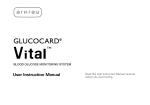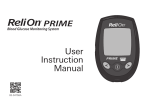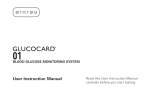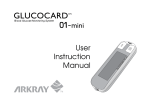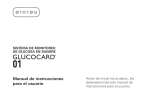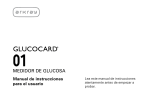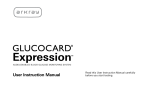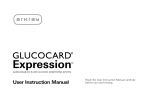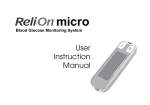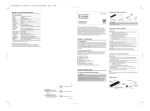Download Arkray Glucocard X-Meter Instruction manual
Transcript
User Instruction Manual Read this User Instruction Manual carefully before you start testing. CAUTION: Before using any product to test your blood sugar (blood glucose), read all instructions and practice the test. Do all quality control checks as directed and consult with a diabetes healthcare professional. These recommendations apply to all blood glucose monitoring systems and are supported by the American Association of Diabetes Educators, the American Diabetes Association, the U.S. Food and Drug Administration, and the Health Industry Manufacturers Association. 2 TABLE OF CONTENTS Introduction . . . . . . . . . . . . . . . . . . . . . . . . . . . . . . . . . . . . . . . . . . . . 6 Intended Use . . . . . . . . . . . . . . . . . . . . . . . . . . . . . . . . . . . . . . . . 7 Important Information. . . . . . . . . . . . . . . . . . . . . . . . . . . . . . . . . . 8 The GLUCOCARD Vital System. . . . . . . . . . . . . . . . . . . . . . . . . . . . . . 9 Understanding the GLUCOCARD Vital Blood Glucose Meter. . . . . . 10 Explanation of the Full Display Screen . . . . . . . . . . . . . . . . . . . . 11 GLUCOCARD Vital Test Strips . . . . . . . . . . . . . . . . . . . . . . . . . . . . . 12 Testing with GLUCOCARD Vital test strips. . . . . . . . . . . . . . . . . . . . 13 Important Test Strip Information. . . . . . . . . . . . . . . . . . . . . . . . . 14 Changing the Battery . . . . . . . . . . . . . . . . . . . . . . . . . . . . . . . . . 15 Meter Set Up. . . . . . . . . . . . . . . . . . . . . . . . . . . . . . . . . . . . . . . . 18 Setting the Time and Date . . . . . . . . . . . . . . . . . . . . . . . . . . . . . 18 Using Assure Dose Control Solution . . . . . . . . . . . . . . . . . . . . . . . . 22 Recommended Use of Control Solution. . . . . . . . . . . . . . . . . . . 23 Performing a Control Solution Test. . . . . . . . . . . . . . . . . . . . . . . 24 Comparing Control Solution Results. . . . . . . . . . . . . . . . . . . . . . 28 3 Blood Glucose Testing. . . . . . . . . . . . . . . . . . . . . . . . . . . . . . . . . . . . 30 The Lancing Device. . . . . . . . . . . . . . . . . . . . . . . . . . . . . . . . . . . 30 Inserting a Lancet. . . . . . . . . . . . . . . . . . . . . . . . . . . . . . . . . . . . 30 Obtaining a Drop of Blood . . . . . . . . . . . . . . . . . . . . . . . . . . . . . 33 Disposing The Lancet . . . . . . . . . . . . . . . . . . . . . . . . . . . . . . . . . 34 Performing a Blood Glucose Test . . . . . . . . . . . . . . . . . . . . . . . . . . . 35 Alternate Site Testing (AST). . . . . . . . . . . . . . . . . . . . . . . . . . . . . . . . 39 Important Information About Alternate Site Testing (AST). . . . . 39 Preparing to Test Your Blood Glucose From an Alternate Site. . . . . . . . 41 Performing a Blood Glucose Test From an Alternate Site. . . . . . 42 Downloading Test Results to a Computer. . . . . . . . . . . . . . . . . . . . . 46 Understanding Test results. . . . . . . . . . . . . . . . . . . . . . . . . . . . . . . . 47 Comparing Meter and Laboratory Results . . . . . . . . . . . . . . . . 47 Expected Blood Glucose Readings. . . . . . . . . . . . . . . . . . . . . . 50 High Blood Glucose Readings. . . . . . . . . . . . . . . . . . . . . . . . . . 50 Low Blood Glucose Readings. . . . . . . . . . . . . . . . . . . . . . . . . . 51 4 Diabetes Findings . . . . . . . . . . . . . . . . . . . . . . . . . . . . . . . . . . . Meter Memory . . . . . . . . . . . . . . . . . . . . . . . . . . . . . . . . . . . . . . . . . Marking Results in the Memory . . . . . . . . . . . . . . . . . . . . . . . . . Marking Control Solution Tests. . . . . . . . . . . . . . . . . . . . . . . . . . Marking Other Results . . . . . . . . . . . . . . . . . . . . . . . . . . . . . . . . Recalling Results. . . . . . . . . . . . . . . . . . . . . . . . . . . . . . . . . . . . . Display Screen Images . . . . . . . . . . . . . . . . . . . . . . . . . . . . . . . . . . . Caring For Your GLUCOCARD Vital Blood Glucose Meter . . . . . . . . Cleaning the Meter. . . . . . . . . . . . . . . . . . . . . . . . . . . . . . . . . . . Storage . . . . . . . . . . . . . . . . . . . . . . . . . . . . . . . . . . . . . . . . . . . Specifications . . . . . . . . . . . . . . . . . . . . . . . . . . . . . . . . . . . . . . . . . . Warnings, Precautions, and Limitations. . . . . . . . . . . . . . . . . . . . . . Warranty. . . . . . . . . . . . . . . . . . . . . . . . . . . . . . . . . . . . . . . . . . . . . . The GLUCOCARD Vital Blood Glucose Meter. . . . . . . . . . . . . . . The Lancing Device. . . . . . . . . . . . . . . . . . . . . . . . . . . . . . . . . . . 51 54 54 54 55 55 59 64 64. 64 66 67 69 69 70 5 INTRODUCTION Thank you for choosing the GLUCOCARD Vital Blood Glucose Monitoring System. Frequent blood glucose testing is important. It tells you how your diabetes is affected by factors such as medication, diet, exercise, and stress management. Blood glucose test results can also tell you if your diabetes is changing in ways that affect your treatment plan. Always consult your diabetes healthcare professional before making any changes. All of the information needed to use the GLUCOCARD Vital System is included in this manual. Please read it thoroughly before using the system. If you have any questions, call ARKRAY Customer Service at 800.566.8558 (24 hours a day, 7 days a week, USA and Canada only). Contact your healthcare professional with questions if you are unable to reach Customer Service. 6 Intended Use The GLUCOCARD Vital Blood Glucose Monitoring System is intended for the quantitative measurement of glucose in fresh capillary whole blood samples drawn from the fingertips or palm. Testing is done outside the body (In Vitro Diagnostic Use). It is indicated for use at home (over the counter [OTC]) by persons with diabetes, or in clinical settings by healthcare professionals, as an aid to monitor the effectiveness of diabetes control. It is not intended for the diagnosis of or screening for Diabetes Mellitus, and is not intended for use on neonates. 7 Important Information • Test results below 70 mg/dL indicate low blood glucose (hypoglycemia) • Test results above 240 mg/dL indicate high blood glucose (hyperglycemia) • If results are below 70 mg/dL or above 240 mg/dL, repeat the test • If results continue to measure below 70 mg/dL or above 240 mg/dL consult your diabetes healthcare professional immediately • If symptoms are not consistent with test results AND all the instructions have been followed carefully, contact your diabetes healthcare professional • Before testing, always make sure both the meter and test strips are at operating temperature 8 THE GLUCOCARD Vital SYSTEM The GLUCOCARD Vital System Includes: • GLUCOCARD Vital Meter • Carrying Case • User Instruction Manual • Self-testing Logbook • May include Test Strips, Control Solution, and Lancing Device and/or Lancets 9 UNDERSTANDING THE GLUCOCARD Vital BLOOD GLUCOSE METER Back Front Data Connection Port Display Screen Back Button On/Off Button Forward Button Test Strip Port Battery Compartment Cover 10 Explanation of the Full Display Screen Control Solution Test Low Battery Time Memory Mode Date Unit of Measurement Average Test Reading Error Code Result Warning Temperature Warning Test Strip Insert/Remove Test Strip Main Display: Test Strip Code Test Countdown Test Results Error Codes Apply Blood If any part of the display screen is missing when the meter is turned on call Customer Service at 800.566.8558. 11 GLUCOCARD Vital TEST STRIPS TEST STRIP These capillary action test strips require only 0.5 µl of blood and provide an end-fill sample application tip for easy blood application. The GLUCOCARD Vital Blood Glucose Monitoring System measures the amount of glucose (sugar) in fresh capillary whole blood. When a drop of blood is added to the sample application tip, the sample is drawn into the test strip reaction site. The glucose in the blood reacts with the enzyme on the test strip. This reaction produces a current, proportional to the amount of glucose in the blood. The meter detects the current and converts it into a blood glucose reading. 12 Test Strip Contact Bars Reaction Site Sample Application Tip (apply blood to end of test strip and capillary action will pull blood to reaction site quickly and easily) TESTING WITH GLUCOCARD Vital TEST STRIPS The GLUCOCARD Vital Blood Glucose Monitoring System works with the GLUCOCARD Vital Test Strips. Important Test Strip Information • Store the test strip bottle in a cool, dry place between 39°F– 86°F (4°C–30°C) • Keep away from direct sunlight and heat • Do not refrigerate or freeze • Do not store or transfer the test strips outside the original bottle • As soon as you have removed a test strip, replace the cap securely on the bottle • Use test strips within 90 days (3 months) of opening and not beyond the expiration date ( ) 13 Important Test Strip Information • Write the date of opening on the bottle label to remind you to discard the strips after 90 days (3 months) • Do not bend, cut, or alter a test strip • Do not reuse a test strip • Use only GLUCOCARD Vital Test Strips with the GLUCOCARD Vital Meter • Ensure your hands are clean and dry before handling test strips 14 Changing the Battery The GLUCOCARD Vital Blood Glucose Meter has a CR2032 battery installed. Note: Changing the battery should only take a few seconds. If the battery is changed within 30 seconds, the meter memory is not affected. You will not lose any past test results and the settings are not affected. However, if it takes longer than 30 seconds to change the battery, or if the battery is dead before changing it, the time and date settings may need to be reset. The first time the meter is turned on after changing the battery, you may see a display screen message (E00). This means you should check that the time and date are correct. (See pages 18-21 for detailed instructions on changing the time and date). 15 WARNING: Keep all batteries out of children’s reach. If a battery is swallowed, consult a doctor immediately. When the battery power is getting low, your meter shows . You have enough power for about 100 tests before you need to replace the battery. If the is flashing, there is only enough power for about 20 tests. Replace the battery as soon as possible. When the battery has run out, the meter will not work. 16 CR 2032 Li-Mn 3V + How to Change the Battery Step 1 Turn the meter off. The battery cover is on the back of the meter. Step 2 Pull the battery cover up with your finger or fingernail. Remove battery cover. Step 3 Remove the old battery. If necessary, turn the meter over and tap it gently against the palm of your hand until the battery falls out. Avoid the use of sharp objects that may damage the meter. Step 4 Insert the new battery. The “+” on the battery should be facing up. Step 5 Replace the battery cover. 17 Meter Set Up Before using the GLUCOCARD Vital Meter for the first time, you must set the time and date. You can choose between the 12-hour format (1-12 o’clock with am or pm) and the Military 24-hour format (0-23). The date format can either be displayed as month/day (U.S.A. format) or day/month (International format). Do not perform a blood glucose test until you have set the meter correctly. Setting the Time and Date Step 1: Turn on meter Press the On/Off button to turn the meter on. The full screen appears briefly. If any part of the display screen is missing (see page 11), call Customer Service. The meter then displays the time, date, unit of measurement, and the insert test strip symbol. Step 2: Enter set-up mode Press and hold down the On/Off button for more than 2 seconds to enter the set-up mode. 18 Step 3: Set the time format The time can be displayed in either 24-hour format or 12-hour format with AM and PM. The meter displays the current time format. To change format, press either the Back or Forward button. Press the On/Off button to select the time format. The date format then appears on the display. Step 4: Set the date format The date format can either be displayed as month/ day (01/31) or day/month (31/01). The meter displays the current format. To change format, press either the Back or Forward button. Press the On/Off button to select the date format. The hour setting then flashes on the display. Month/Day Format Day/Month Format 19 Step 5: Set the hour Press and release the Back or Forward button to change the hour. Hold the Back or Forward button down to scroll through quickly. When the correct hour is displayed, press the On/Off button. The minute setting then flashes on the display. Step 6: Set the minute Press and release the Back or Forward button until the correct minute appears. Hold the Back or Forward button down to scroll through quickly. When the correct minute is displayed, press the On/Off button. The month setting then flashes on the display. Step 7: Set the month (If day/month format is selected then Step 7 will set day) Press and release the Back or Forward button until the correct month appears. Hold the Back or Forward button down to scroll through quickly. When the correct month is displayed, press the On/Off button. The day setting then flashes on the display. 20 Hour flashing Minute flashing Month flashing Step 8: Set the day (If day/month format is selected then Step 8 will set month) Press and release the Back or Forward button until the correct day appears. Hold the Back or Forward button down to scroll through quickly. When the correct day is displayed, press the On/Off button. The year setting then flashes on the display. Step 9: Set the year Press and release the Back or Forward button until the correct year appears. Hold the Back or Forward button down to scroll through quickly. When the correct year is displayed, press the On/Off button for two seconds to exit set up mode. Day flashing Year flashing Note: Pressing the On/Off button for more than 2 seconds at any stage saves the time and date and exits the set-up mode. The meter automatically shuts off after 2 minutes if no buttons are pressed. Settings stored up to that point are saved. 21 USING ASSURE® DOSE CONTROL SOLUTION Use the Assure Dose Control Solution to check that the meter and test strips are working correctly. It is important that you carry out this simple check regularly. Assure Dose Control Solution contains a known amount of glucose that reacts with the GLUCOCARD Vital Test Strip. Assure Dose Control Solutions are available in two levels - Normal and High. Compare the control solution test results with the range printed on the test strip bottle label. Call your local supplier or pharmacy if you need to order control solution. If they do not stock the product, please call Order Services at 800.566.8558 (USA and Canada only). 22 It is recommended to use Control Solution: • When you open a new bottle of test strips. • Whenever you suspect the meter or test strips may not be functioning properly. • If test results appear to be abnormally high or low or are not consistent with clinical symptoms. • If the test strip bottle has been left open or has been exposed to light, temperatures below 39°F(4°C) or above 86°F(30°C), or humidity levels above 80%. • To check your technique. • When the GLUCOCARD Vital Meter has been dropped or stored below freezing or above 122°F(50°C). • Each time the batteries are changed. 23 Performing a Control Solution Test Before performing a control solution test, always check the expiration date ( ) of the control solution. Do not use control solution if it is past the expiration date or if the solution has not been stored correctly. When you open a new bottle of control solution, always write the date of opening on the control solution label. As soon as you have used the control solution, put the cap back on the bottle. Always use the control solution within 90 days (3 months) of first opening. 24 Step 1 Firmly insert a GLUCOCARD Vital Test Strip into the meter. Insert the contact bars into the test strip port, with the reaction site facing up. Firmly insert test strip using bottom of test strip port as a guide. Align test strip as shown in diagram. When the strip is inserted, the meter turns on automatically. The full screen appears briefly. If any part of the display screen is missing (see page 11), call Customer Service. The screen then displays the test strip symbol and flashing blood drop. < < Test Strip Port Contact Bars Reaction Site Sample Application Tip 25 Step 2 You must press the Back or Forward button BEFORE performing control solution test. Hold the Back or Forward button until appears in the upper right corner of the screen. Verify that remains displayed on the screen. If you do not do this, the control solution result will NOT be valid. will prompt you to add control solution. Step 3 Mix control solution by gently inverting control solution bottle several times. Remove the cap from the control solution bottle. Place cap on flat surface. Squeeze the bottle and discard the first drop. Apply the second drop to the top of the cap. 26 < < Step 4 Bring meter and test strip to the drop. Test strip will draw up the solution. The meter will show result in 7 seconds. Note: Dye added to control solution may stain surfaces or fabric. Use with care. 06146A 2010-10 Control Solution Range (mg/dL) (Rango de la solución de control) Step 5 Compare the result with the range printed on the test strip bottle you are using. Values may vary from bottle to bottle. Verify that the result is within range of the control solution level that you are using. If the result falls within the range on the bottle, the meter is working correctly. Normal: High: 80-120 200-300 Step 6 Remove the test strip. The meter shuts off automatically when the test strip is removed. Dispose of the test strip immediately. 27 Comparing Control Solution Results If the result is outside the range printed on the test strip bottle, repeat the test. One or more of the following may have caused an out-of-range result: • The meter was not placed in control solution mode before adding control solution • The control solution has expired or has been contaminated • The control solution was stored below 35°F (2°C) or above 86°F (30°C) • First drop of control solution was not discarded • The test strip was not stored correctly • The test strip was used after the expiration date of the bottle • The test strip bottle was open for more than 90 days (3 months) • The GLUCOCARD Vital meter has been damaged or has malfunctioned • Contamination due to the tip of the control solution bottle touching the test strip 28 Repeat the test, carefully following instructions, using control solution mode with new control solution or a new test strip, as appropriate. Compare the result with the range printed on the test strip bottle you are using. Note: If your control solution result continues to fall outside the required range, the system may not be working correctly. DO NOT USE the system to test your blood. If you are unable to resolve the problem, call Customer Service at 800.566.8558 (24 hours a day, 7 days a week, USA and Canada only). 29 Lancet Removable cap Adjustment dial Lancing Button BLOOD GLUCOSE TESTING Multi-Lancet Device™ body Band hooks Multi-LancetDisposal-and-set Device™ lever Protective cap Special band (optional) Groove of special band Inserting a Lancet Lancet Removable cap Strap hole Protective cap Adjustment dial Lancing Button Multi-Lancet Device™ body Band hooks Disposal-and-set lever Special band Strap hole (optional) Step 1 Groove of special band Pull the removable cap to remove it. Optional: Remove special band from removable cap. Step 2 Insert a new, unused lancet into the Holder. Firmly press lancet until it stops and fits securely within the Holder. 30 Holder Step 3 Twist off the protective cap. Step 4 Attach the removable cap. NOTE: Do not use the lancet if the cap is missing or damaged. A lancet should only be used once. Dispose of used lancet in a safe manner so as not to cause accidental injury. WARNING: Lancing devices and lancets are for single-patient use only. DO NOT share used lancets with another person. To prevent possible infection, a used lancet should not be touched by another person 31 Step 5 The Multi-Lancet Device offers 7 different levels of skin penetration. For soft or thin skin or first time use, select “1 or 2.” If the obtained amount of blood is excessive, turn the dial to a lower setting. If the obtained amount of blood is insufficient, turn the dial to a larger setting. Level indications 1 2 3 4 5 6 7 Deeper 32 Obtaining a Drop of Blood Step 1 Wash hands with soap and warm water. Dry hands thoroughly. If you use alcohol wipes to cleanse fingers, make sure the area is dry before lancing finger. Residual alcohol may lead to inaccurate readings. Step 2 Let the arm hang down for 10 to 15 seconds. (Holding the arm below the heart and massaging the wrist, palm and finger makes it easier to obtain a blood drop). Step 3 Choose a site on the side of a fingertip to minimize pain. Step 4 Press the Disposal-and-set lever in the direction of the arrow until click is heard. Step 5 Press the removable cap to the side of the fingertip. Press the lancing device button. 33 Step 6 Set aside the Multi-Lancet Device and wait a few seconds for a blood drop to form. Keeping the hand warm, lowering the hand to waist level and gently massaging your wrist, palm or the base of the finger helps the flow of blood. Use a different site each time you test to help prevent soreness and calluses. Disposing the Lancet Step 1 Place the lancet protective cap on a hard surface and remove the removable cap. Step 2 Push the lancet into the protective cap. Step 3 Press the disposal-and-set lever forward to eject the used lancet into an appropriate container. DO NOT share used lancets with another person. To prevent possible infection, a used lancet should not be touched by another person. A lancet should only be used once. After use, put the protective cap back on and dispose of lancet in a safe manner to avoid accidental stick injuries 34 WARNING: Lancing devices and lancets are for single patient use only. Protective Cap PERFORMING A BLOOD GLUCOSE TEST Note: For Instructions on Alternate Site Testing, refer to pages 39-46. Step 1 Insert a GLUCOCARD Vital Test Strip into the meter. Insert the contact bars into the test strip port with the reaction site facing up. Firmly insert test strip using bottom of test strip port as a guide. Align test strip as shown in diagram. < < Test Strip Port Contact Bars Reaction Site Sample Application Tip When the test strip is inserted, the meter turns on automatically. If any part of the display screen is missing (see page 11), call Customer Service. 35 The test strip and flashing blood drop tells you the meter is ready for you to apply a drop of blood to the sample application tip at the end of the test strip. Step 2 Lance your finger using the Lancing Device. Touch the sample application tip at the end of the strip to the blood drop on your finger. The capillary action will pull the blood to the reaction site. Add enough blood to the end of the test strip to completely fill reaction site. ‘Apply Blood’ symbol flashing DO NOT add blood to the top of the test strip. You may receive an abnormal (high) result. CORRECT 36 INCORRECT IMPORTANT: The meter will start to count down when it detects that blood has been applied. Discard test strip if meter does not start to count down after blood drop is applied. IMPORTANT: The minimum sample volume is 0.5 µL. Smaller samples may not start the meter or can start the meter count down and provide an “E13” error message. Ensure blood completely fills reaction site. Enough Blood Not Enough Blood Too Much Blood The meter will count down. The result is displayed in 7 seconds. Displaying the Result 37 Step 3 Always record your results in your self-testing logbook along with other information such as insulin dosage, diet, and exercise. The result is automatically stored in memory with the time and date. Step 4 A lancet should be used once. After use, put protective cap back on and remove lancet from lancing device. Dispose lancet in a safe manner as not to cause accidental injury. Remove the used test strip and dispose of it carefully. The meter shuts off automatically when the test strip is removed. 38 ALTERNATE SITE TESTING (AST) Important Information About AST Sites other than your fingertip may have fewer nerve endings so obtaining a blood sample from these sites may be less painful. The technique for alternate site testing is different from fingertip testing. Blood glucose results from sites other than your fingertip could be significantly different due to blood glucose levels changing rapidly after a meal, insulin, or exercise. Consult with your diabetes healthcare professional prior to testing from a site other than your fingertips. Results obtained from sites other than the fingertip may differ significantly as is the case with all blood glucose monitoring systems. Rapidly changing results are likely to occur after eating. Insulin dosing and physical activity are shown in the fingertip more quickly than in alternate sites. On average, blood taken from the palm may give results as much as 5% higher than blood taken from the fingertip. 39 Consider Alternate Site Testing When: • Testing before a meal • You are in a fasting state • Two hours have passed since a meal • Two hours have passed since insulin dosing • Two hours have passed since physical activity Use Fingertip When Testing: • Within two hours after a meal • Within two hours after insulin dosing • Within two hours after physical activity • If you have a history of hypoglycemia, are experiencing low blood sugar, or suffer from hypoglycemic unawareness (you cannot tell when you have low blood glucose) • To confirm your blood glucose level if your AST result is not consistent with how you feel • During times of stress or illness 40 Ask your diabetes healthcare professional about recommended testing procedures before operating machinery or driving a car, as fingertip testing is usually the preferred method of testing under these circumstances. If bruising occurs, you may choose to lance a fingertip instead. Preparing to Test Your Blood Glucose From an Alternate Site Choose a Site: Select a soft, fleshy area on the palm that is free of visible veins and moles and away from bone. Wash the area with warm, soapy water. Rinse and dry completely. If you use alcohol wipes to cleanse the site, make sure the area is dry before lancing the site. Prepare Your Lancing Device: To order an AST Lancing Kit containing the lancing device, lancets, and instructions, please call 800.566.8558. 41 Performing a Blood Glucose Test From an Alternate Site Step 1 Insert lancet and cock lancing device. Step 2 a) Insert a test strip into the meter. Insert contact bars into test strip port with reaction site facing up. When the strip is inserted, the meter turns on automatically. Make sure all symbols appear on the screen (see page 11). < < Test Strip Port Contact Bars Reaction Site Sample Application Tip 42 Insert into meter this way IMPORTANT! b) Wait until strip with flashing blood drop appears. (You now have 2 minutes to apply blood drop before meter shuts off). Step 3 a) Vigorously rub the selected area for 5 to 10 seconds until it starts to feel warm to the touch. b) Firmly hold the cocked lancing device against the clean skin for 5 to 10 seconds. c) Press the release button on the lancing device to lance the skin. Continue to hold the lancing device firmly against the skin until a 0.5 µL blood drop forms d) Once a large enough drop of blood has formed, remove the lancing device. 43 IMPORTANT • Repeat blood draw if fluid is not a deep red color. • DO NOT TEST BLOOD if sample is smeared, flattened out, or not forming a round drop. Repeat steps starting with Step 3. Step 4 Pick up the meter. Touch the end of the test strip to the blood sample until the reaction site is full. Immediately remove the meter and test strip from the blood drop. 44 < < IMPORTANT • Was the sample a deep red color and free of watery fluid? • Was the drop large enough (at least 0.5 µL)? • Did the reaction site fill with enough blood all at once? IF NOT, REPEAT TEST. Step 5 The meter will count down and display result in 7 seconds. CONSIDER YOUR RESULT. REPEAT ALTERNATE SITE TEST: •IF the blood sample appeared to be diluted with clear fluid. • IF you did not vigorously rub the test site. • IF the blood drop was not large enough to fill the reaction site • IF the test was accidentally marked as a “Control” result. • IF your result was not consistent with how you feel. Any of the above situations can lead to an inaccurate test result. Enough Blood Not Enough Blood Too Much Blood 45 If the repeated alternate site result is still not consistent with how you feel, confirm your blood glucose level with fingertip testing. Step 6 Always record your results in your self-testing log book along with other information such as insulin dosage, diet, and exercise. The result is automatically stored in memory with the time and date. Step 7 Remove the test strip and dispose of it carefully. A lancet should be used once. After use, put protective cap back on and remove lancet from lancing device. Dispose lancet in a safe manner as not to cause injury. The meter shuts off automatically when the test strip is removed. DOWNLOADING TEST RESULTS TO A COMPUTER We offer a variety of diabetes management software systems to help you download your test results to a computer. For more information on ARKRAY Diabetes Management Software and which software system meets your needs, call ARKRAY Customer Service at 800.566.8558 (24 hours a day, 7 days a week, USA and Canada only). 46 UNDERSTANDING TEST RESULTS NOTE: The GLUCOCARD Vital Meter is designed to give results at temperatures between 41°F - 113°F (5°C - 45°C) and relative humidity (noncondensing) of 20–80%. Comparing Meter and Laboratory Results Your GLUCOCARD Vital Blood Glucose Meter is referenced to fresh plasma blood measurement. This was performed in a clinical laboratory with glucose standard calibration to the NIST (National Institute of Science and Technology, Gaithersburg, MD, USA). The results you get from your meter may differ from the tightly controlled clinical laboratory result. This is due to normal variation. To make an accurate comparison between the meter and laboratory results, follow the guidelines below. 47 Before You Compare Perform a control solution test to make sure your meter and test strips are working correctly. Wait at least 2 hours after a meal or drink (other than water) before doing comparison blood tests. Fasting is essential if venous blood is required for the reference analyzer. When at the Laboratory The capillary samples for both tests must be taken and tested within 15 minutes of each other. The sample must be collected with anticoagulant appropriate to the laboratory analyzer. The recommended technique should be followed. Analysis should be performed following the manufacturer’s guidelines. ALWAYS wash hands in warm, soapy water. Rinse and dry them thoroughly before testing. ALWAYS use fresh capillary whole blood on meter tests. 48 You may still experience a difference from the laboratory result because blood glucose levels can change over short periods. This can be for a variety of reasons, such as food, exercise, medication, hematocrit, stress, or loss of body fluids. Data analysis should be performed using a clinically acceptable method. Circulating blood glucose fluctuates naturally over time. Test results can vary over time and can be affected by several factors. Some of these include, but are not limited to, the following: (1) time of day the test was performed; (2) food eaten; (3) activities performed; (4) insulin and other medications taken. If your result does not seem correct after testing your blood, repeat the test. If abnormally high or low readings persist, contact your healthcare professional. 49 Expected Blood Glucose Readings Expected blood glucose levels for people without diabetes:1, 2 Fasting 70-110 mg/dL mg/dL 2 hours after meals 70-140 mg/dL High Blood Glucose Readings If your blood glucose is above 600 mg/dL, you will receive a “Hi.” Repeat the test with a new test strip. If this message shows again, contact your healthcare professional immediately! Contact your physician for advice if test results are very high3 (above 240 mg/dL) and/or you have symptoms of high blood glucose. These symptoms include dry mouth, thirst, frequent urination, nausea, vomiting, blurred vision, sleepiness, or abdominal pain. Symptoms will vary from person to person. You may have one or all of these symptoms. 50 Low Blood Glucose Readings If your blood glucose is below 20 mg/dL, you will receive a “Lo.” Repeat the test with a new test strip. If this message shows again, contact your healthcare professional immediately! Contact your physician for advice if test results are very low4 (below 70 mg/ dL) and/or you have symptoms of low blood glucose. Symptoms of low blood glucose include sweating, shakiness, trembling, blurred vision, hunger, headache, confusion, rapid heartbeat, or tingling or numbness around the mouth or fingertips. Symptoms will vary from person to person. You may have one or all of these symptoms. Diabetes Findings In 1993, the National Institute of Health concluded an extensive long-term study of people with Type 1 diabetes. This study, called the Diabetes Control and Complications Trial (DCCT), found that by keeping your blood glucose close to the levels of people without diabetes you can reduce the risk of complications involving the eyes, kidneys, and nervous system by approximately 60%5. 51 What This Means for You Frequent blood glucose testing is the best means you have for keeping track of how well you are doing with the factors that affect your diabetes-medication, diet, exercise, and stress management. Blood glucose test results can also tell you whether your diabetes is changing in ways that might require an adjustment to your treatment plan. Always consult your healthcare professional before making any changes in managing your diabetes. Frequency of Testing How often you need to test your blood glucose will vary according to your age, the type of diabetes you have, the medications you are taking, and your physical and emotional health. Your healthcare professional will guide you. After deciding when and how often you should test, it is important that you make testing part of your routine. 52 Recommendations for better diabetes control • Follow the advice of your healthcare professional. • Follow the exercise and meal plans recommended by your healthcare professional. • Take insulin or diabetes medication at your scheduled times. • Keep in touch with your emotional and physical condition. • Stress or illness can affect diabetes. • Watch for symptoms of hypoglycemia (low blood glucose) and hyperglycemia (high blood glucose). • Always record your test results in your logbook. The logbook assists you in keeping a record of your blood glucose results, along with information on your food intake, exercise, and medication. • Review your logbook of test results with your healthcare professional regularly. References 1 2 3 4 5 “ Definition and diagnosis of diabetes mellitus and intermediate hyperglycaemia” World Health Organization, 2006 Diabetes Care, vol. 33 Jan;1 S82-86, 2010 Krall, L.P. and Beaser R.S.: Joslin Diabetes Manual. Philadelphia: Lea and Fibiger (1989), 261–263. Kahn, R. and Weir, G.: Joslin’s Diabetes Mellitus. Philadelphia: Lea and Fibiger (1994), 489. American Diabetes Association position statement on the Diabetes Control and Complications Trial (1993). 53 METER MEMORY Marking Results in the Memory You can mark results in the meter memory in two ways. Marking Control Solution Tests You must mark results with the control bottle symbol . Insert test strip into the meter. Hold the Back or Forward button until appears in the upper right corner of the screen. Do this BEFORE performing a control solution test. If you do not mark control solution tests before applying control solution to the test strip, the results may not be accurate and control solution test results will be included in your test result averages. The meter does not use results marked when it calculates the 14- and 30-day average. This ensures that your 14- and 30-day average includes only results from testing your own blood. To mark a result , press the Back or Forward button BEFORE testing with control solution. (See page 22 for detailed instructions on testing with control solution). 54 Marking Other Results You can also mark results with an when you do NOT want to include the result in your 14- and 30-day average. For example, if someone else used your meter, or if you believe the test result is incorrect because you applied blood to the test strip incorrectly, use the exclamation mark to ensure that your 14- and 30-day average includes only those results from testing your own blood that you want included in your average. To mark a result with , press the Back or Forward button AFTER the meter displays the test result. Recalling Results Step 1 Press the On/Off button to turn on the meter. Then press the Back or Forward button. Do not insert a test strip to turn on the meter. is displayed when the memory mode is entered. The meter displays the most recent test result stored in the memory. mg/dL < < < < 55 Step 2 Press the Back or Forward button to display the average of tests over the last 14 days. This can include 1 to 250 results, depending on how frequently you test. The number at the top (20n) shows the number of tests that have produced the average. is displayed when the average is shown. Step 3 Press the Back or Forward button again to display the 30-day average. The greater the frequency of testing the higher this number will be. is displayed when the average is shown. Displaying the average (14 day) Displaying the average (30 day) If no results are stored, or you are using the meter for the first time, the meter will display 3 bars. 56 No results stored If a test has not been performed in the last 14 days the meter will display the 14-day average screen with 3 bars. This means there are no results stored to produce the average. If a test has not been performed in the last 30 days the meter will display the 30-day average screen with 3 bars. Step 4 Press the Back and Forward buttons to recall other results stored in the memory. Pressing the Forward button after the average displays the oldest test in memory. Pressing the Back button after the average displays the second most recent test in memory. mg/dL < < The meter displays the time each test was recorded in the upper left corner. The date of the test appears below the time. 57 Results marked with when the test was performed are not included in the average. The marked results can be seen when you scroll through the results saved in the memory. The memory mode also displays if the result was marked before using control solution. These results are not included in the 14- and 30-day average. If the thermometer symbol is flashing when you perform a test, the thermometer symbol will be displayed in the memory with the result. These results will not be included in the meter averages. Step 5 Press the On/Off button to return to the user mode. If you are not going to test, press the On/Off button again to shut off the meter. 58 NOTE: Results that appear as LO are included as 20 mg/dL in the glucose averages. Results that appear HI are included as 600 mg/dL in the glucose averages. DISPLAY SCREEN MESSAGES A list of all display screen messages is included below. If you have any questions after reading these messages, or if the meter displays a message not listed here, call Customer Service at 800.566.8558 (24 hours a day, 7 days a week, USA and Canada only). If the display screen shows , you should be able to clear the error message yourself. Do not send your meter to ARKRAY or your local dealer without authorization from a company representative. Your blood glucose level is less than 20 mg/dL. Repeat the test using a new test strip. If this message appears again, contact your healthcare professional immediately. Your blood glucose level is more than 600 mg/dL. Repeat the test using a new test strip. If this message appears again, contact your healthcare professional immediately. 59 The battery has been replaced. Check that the time and date are set correctly. A used strip has been inserted or the meter is having difficulty reading the strip. Repeat the test with a new test strip. The battery power is getting low. There is enough power for approximately 100 tests before the battery needs to be replaced. 60 The battery power is low. There is only enough power for about 20 more tests. Replace with a new CR2032 battery as soon as possible. The battery power is too low for testing. Replace with a new CR2032 battery. 61 Thermometer flashing. The meter and test strips are outside the optimum temperature range of 50°F - 104°F (10°C - 40°C). Make sure your meter and strips are in an environment with a temperature between 50°F - 104°F (10°C - 40°C). Treat test result obtained where the thermometer is flashing with caution. The flashing thermometer will be displayed on all screens during glucose testing until the meter has reached acceptable temperature. Readings obtained with the flashing thermometer will show a thermometer when results are recalled in memory. Thermometer symbol - E6. Temperature outside of acceptable range of 41°F - 113°F (5°C - 45°C). You will not obtain a reading. Allow the meter and strips to warm up or cool down slowly to between 50°F - 104°F (10°C - 40°C) or at least to 41°F 113°F (5°C - 45°C). 62 Corrupted memory. Call Customer Service at 800.566.8558. Not enough blood was added to test strip. Retest with new test strip. Apply at least 0.5µL of blood to sample application tip. 63 CARING FOR YOUR GLUCOCARD Vital BLOOD GLUCOSE METER Cleaning the Meter The GLUCOCARD Vital Blood Glucose Meter is a precise instrument. Please handle it with care. Clean the outside of the meter with a damp cloth only. Dirt, dust, blood, control solution, or water entering the meter could cause damage. Your GLUCOCARD Vital Blood Glucose Meter should not need decontamination as no blood or control solution should come into contact with the meter if the instructions are followed correctly. Storage The GLUCOCARD Vital Blood Glucose Meter is designed to be stored within a 32°F - 122°F (0°C - 50°C) temperature range. • Do not leave your meter in extremely hot or cold places such as near a heat source (radiator) or in a car in very hot or cold weather • Do not store or use your meter or test strips where they may be exposed to high humidity, such as in a bathroom or kitchen 64 • Never hold the meter or test strips under running water • Do not use or store your meter on or near a strong electro-magnetic field such as a microwave oven, stereo amplifiers, or a mobile phone • Do not store your meter or test strips near bleach or cleaners that contain bleach 65 SPECIFICATIONS Test Strips: GLUCOCARD Vital Result range: 20 to 600 mg/dL Calibration: Plasma referenced Sample Size: Minimum 0.5 µL Blood Source: Capillary Whole Blood Hematocrit Range: 33%-52% Test Time: 7 seconds Glucose Units: mg/dL Assay Method: Biosensor, Glucose oxidase (Aspergillus niger sourced) Power Source: Single replacement 3V (CR2032) battery Battery Life: More than 2,000 tests at 4 tests per day Display Type: Liquid Crystal Display (LCD) Memory: 250 results with 14- and 30-day averaging Automatic Shut-off: 2 minutes after last user action Size: Approx. 3" x 2" x ½" (80 mm x 46 mm x 16 mm) Weight: Approx. 1½ oz. (39 g) Optimum Operating Ranges: 50°F - 104°F (10°C - 40°C) Relative Humidity: 20% - 80% Altitude: 10,000 ft. (3,048 meters) 66 WARNINGS, PRECAUTIONS, AND LIMITATIONS •The GLUCOCARD Vital Blood Glucose Monitoring System is not designed to substitute for pathology laboratory equipment and should not be used for the diagnosis of diabetes. •Severe dehydration (excessive water loss) may cause false low results. If you believe you are suffering from dehydration, consult your healthcare professional immediately. •A red blood cell count (hematocrit) that is very high (above 52%) can give abnormally low results. A very low hematocrit level (below 33%) can give abnormally high results. •Inaccurate results may occur in severely hypotensive individuals or patients in shock. •Inaccurate low results may occur for individuals experiencing a hyperglycemic-hyperosmolar state, with or without ketosis. •Patients undergoing oxygen therapy may yield false results. •Do not use to test newborns. The system has not been validated for neonatal use. 67 •Do not use the GLUCOCARD Vital system at altitudes in excess of 10,000 ft (3,048 m). •Triglycerides up to 3,300 mg/dL do not significantly affect test results. However, glucose values in specimens beyond this triglycerides level should be interpreted with caution. •Metabolites of icodextrin (maltose, maltotriose, and maltotetraose) do not affect test results. •Use only fresh capillary blood. Do not use serum or plasma or venous whole blood. IMPORTANT: Low or high blood glucose readings can indicate a potentially serious medical condition. If your blood glucose reading is unusually low or high, or you do not feel the way your readings indicate, repeat the test using a new strip. If your result is still not consistent with your symptoms or if your blood glucose result is less than 60 mg/dL or higher than 240 mg/dL, contact your diabetes healthcare professional for advice. 68 WARRANTY THE GLUCOCARD Vital BLOOD GLUCOSE METER You are a valued customer of ARKRAY. It is important to us that you are completely satisfied with your GLUCOCARD Vital Blood Glucose Meter. ARKRAY warrants that your GLUCOCARD Vital Meter will be free from defects in materials and workmanship for a period of five years from the date of the original purchase. If during this time the meter does not work properly because of a defect in materials or workmanship, ARKRAY agrees to replace or repair, free of charge any and all parts proven to be defective and subject to warranty. This warranty is in lieu of all other warranties, expressed or implied, including any implied warranty of merchantability or fitness for any purpose, other than stated herein. 69 This warranty does not apply to the performance of the GLUCOCARD Vital meter that has been damaged by accident or has been altered, misused, tampered with, or abused in any way. This warranty only applies to the original purchaser of the meter and/or its agents. THE LANCING DEVICE ARKRAY warrants that the Lancing Device functions effectively for a period of 3 years from the date of purchase. A malfunctioning device should not be returned to your supplier or to ARKRAY unless you receive an authorization number to do so. 70 NOTES 71 RETURNS You must contact ARKRAY Customer Service at 800.566.8558 before returning your meter. If you are located outside of the USA and/or Canada, please contact your ARKRAY distributor. You will be instructed how to return the meter to ARKRAY. Returned meters without this authorization will not be accepted. ARKRAY USA, Inc. Minneapolis, MN 55439 USA TEL 800.566.8558 FAX 952.646.3110 www.arkrayusa.com ©2011 ARKRAY, Inc. GLUCOCARD® is a registered trademark of ARKRAY P/N 1850-02 Rev 3/11








































































